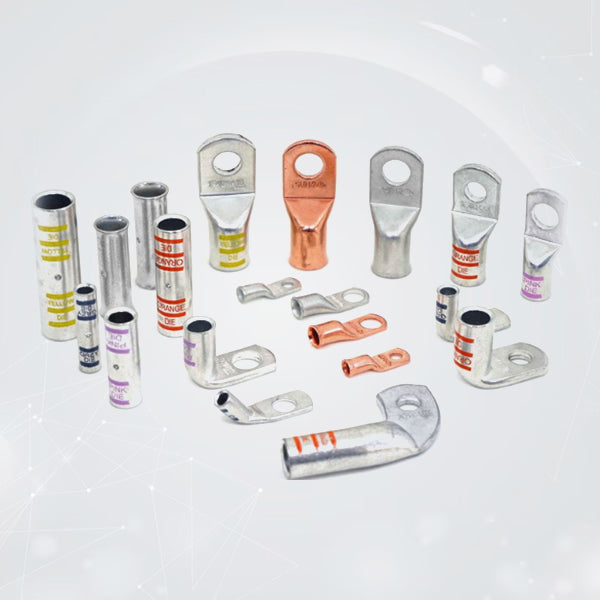
Connecting Power: Bare Copper Lugs in Electrical Panels - Ensuring Robust and Efficient Connections
Electrical panels serve as the central nervous system of any electrical distribution system, orchestrating the flow of power to various circuits and devices. Within these panels, the reliability and efficiency of connections are paramount. Bare copper lugs play a crucial role in establishing these connections, providing a robust and conductive interface between cables and panel components. This guide explores the importance of bare copper lugs in electrical panels, their specific applications, and the best practices for ensuring optimal performance and safety.
Understanding Bare Copper Lugs
Before delving into the specifics of their application in electrical panels, it's essential to understand what bare copper wire lugs are. These connectors are made from pure copper, a highly conductive metal that facilitates the efficient transfer of electrical current. Unlike tinned lugs, which are coated with a layer of tin for corrosion protection, bare copper lugs are left uncoated, relying on the inherent conductivity of copper for their performance.
The Role of Lugs in Electrical Panels
Lugs, in general, are essential components in electrical systems. They provide a secure and reliable termination point for wires and cables, allowing them to be connected to various electrical devices. In electrical panels, Wire lugs serve several critical functions:
- Connecting Incoming Power: Lugs are used to connect the main power cables to the panel's busbars or main lugs, establishing the initial point of power distribution.
- Distributing Power to Circuits: Lugs connect the branch circuit wires to circuit breakers or fuses, enabling the distribution of power to individual circuits within the building or facility.
- Grounding Connections: Lugs are used to establish grounding connections, ensuring a safe path for fault currents and protecting against electrical shock.
Why Use Bare Copper Lugs in Electrical Panels?
Bare copper lugs are a preferred choice in electrical panels due to their exceptional conductivity. Copper's low resistance minimizes energy loss in the form of heat, ensuring efficient power transfer. This is particularly important in high-current applications, where even small inefficiencies can lead to significant energy waste and potential overheating.
Advantages of Bare Copper Lugs in Electrical Panels
- Superior Conductivity: The primary advantage of bare copper lugs is their unmatched conductivity. Copper's low resistance ensures that electrical current flows smoothly and efficiently, minimizing voltage drops and maximizing power delivery.
- High Current Capacity: Bare copper lugs can handle high currents without overheating, making them suitable for the demanding conditions within electrical panels.
- Durability: Copper is a durable material that can withstand the mechanical stresses and temperature fluctuations within electrical panels.
Applications of Bare Copper Lugs in Electrical Panels
Bare copper lugs find widespread use in various applications within electrical panels:
- Main Service Connections: Connecting the main power cables to the panel's main lugs or busbars.
- Branch Circuit Connections: Connecting branch circuit wires to circuit breakers or fuses.
- Grounding Busbar Connections: Establishing connections to the grounding busbar for safety.
Best Practices for Using Bare Copper Lugs in Electrical Panels
To ensure optimal performance and safety when using bare copper lugs in electrical panels, it's crucial to follow best practices:
- Lug Selection: Choose the correct size and type of bare copper wire lug for the wire and the application. Ensure that the lug is rated for the current and voltage requirements of the circuit.
- battery cable lugs Preparation: Prepare the cable correctly by stripping the insulation to the appropriate length and ensuring that the wire strands are clean and undamaged.
- Crimping Technique: Use a crimping tool that is designed for the specific size and type of lug. Apply firm, even pressure to create a secure and gas-tight crimp.
-
Connection Cleaning: Ensure that the lug and the connection point in the panel are clean and free from any contaminants.
-
Torque Specifications: Tighten the lug connections to the manufacturer's recommended torque specifications to ensure a secure and reliable connection.
- Inspection: Regularly inspect the connections for any signs of loosening, corrosion, or overheating.
Technical Details Recap
• Material: Pure Copper
• Key Benefit: Superior Conductivity
• Application: Power Connections in Electrical Panels
Bare copper battery cable ends are essential components in electrical panels, providing the robust and conductive connections necessary for efficient and safe power distribution. By adhering to best practices for installation and maintenance, electricians and technicians can ensure the reliability and longevity of electrical systems.

